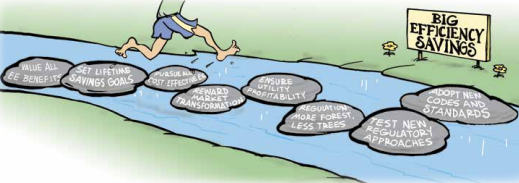| |
|
|
Energy
Solutions for
a Changing
World
|
|
The Next
Quantum Leap
in
Energy
Efficiency -
Game On
Ten
years ago, the
most
aggressive
electric
efficiency
efforts in the
country were
achieving
first-year
electric
savings of
about 1.0
percent of
annual sales.
Today,
at least five
different
states have—or
plan to—double
those levels
of savings,
achieving
between 2.0
and 2.5
percent
first-year
savings
annually.
Since 2006,
nationwide
customer
efficiency
spending has
nearly
quadrupled,
from $1.6 to
$5.9 billion,
and
substantial
additional
savings have
been realized
through
federal
equipment
efficiency
standards,
building
codes, and
other
regulatory
mechanisms.
By
many measures,
we have made
solid progress
on energy
efficiency
over the last
decade. But
there
continues to
be room for
more of this
low-cost,
high-benefit
resource.
“It
looks like
many states
are getting
the message,”
says Rich
Sedano, RAP
principal and
US program
director.
“Every state
may want to
take a fresh
look at the
possibilities
for upping
their game on
energy
efficiency—there
continues to
be
considerable
space to
grow.”
|
Webinar: The Energy Efficiency Quantum Leap
A
recent RAP
webinar
explores the
next quantum
leap in
efficiency
savings. Chris
Neme of Energy
Futures Group
(EFG) shared
the findings
of a study (mentioned above) he co-wrote with
Jim Grevatt
for RAP
demonstrating
how states can
achieve
persistent
savings of 30
percent of
load over ten
years. This
quantum leap
in efficiency
cannot be
brought about
without major
policy
changes,
including
increasing
ratepayer
funding of
energy
efficiency,
making
efficiency
more
profitable for
utilities,
aligning
efficiency
goals with
long-term
objectives,
and creating
new models for
acquiring
efficiency.
|
Recognizing
Early Action
Under The
Clean Power
Plan
-Ken
Colburn
Data
suggest that
the electric power sector’s long march toward
decarbonization
was already
well underway
before the
EPA’s Clean
Power Plan
(CPP)
rulemaking,
let alone the
final rule’s
compliance
period, which
doesn’t begin
until 2022. If
so, then the
emissions
reduction
obligations
imposed by the
CPP might be
characterized
as consistent
with the
dramatic
changes
already
underway
within the
power sector
as much as
they are a
driver of
those changes.
This is an
encouraging
characterization,
because it
suggests that
compliance
with the CPP
is likely to
be
accomplished
without
departing
greatly from
the utility
resource
planning and
state policy
pathways
already in
motion. Some
are concerned,
however, that
the CPP could
temporarily
slow the
adoption of
cleaner, more
renewable
energy sources
and more
efficient
end-use of
energy.
|
|
Webinars
Teaching
the Duck to
Fly - Second
Edition
March 3,
2016
1
p.m. EST
Join us for a webinar where Jim Lazar shares
new insights
on
opportunities
that have
arisen and
technologies
that have
evolved since
his 2014 paper
Teaching the Duck to Fly. Drawing from
the
soon-to-be-released
Teaching
the Duck to
Fly - Second
Edition,
Mr. Lazar will
discuss each
of the
strategies,
how they can
be deployed
and managed,
and how each
affects the
load shape
that remains,
thus
demonstrating
that the
amount of
flexibility
they can
provide has
increased.
Together,
these measures
enable
utilities to
adapt to a
supply
portfolio
containing a
high level of
variable
renewable
energy
resources and
still provide
adequate,
reliable, and
economical
service to
consumers.
|
|
|
|
|
|
|

